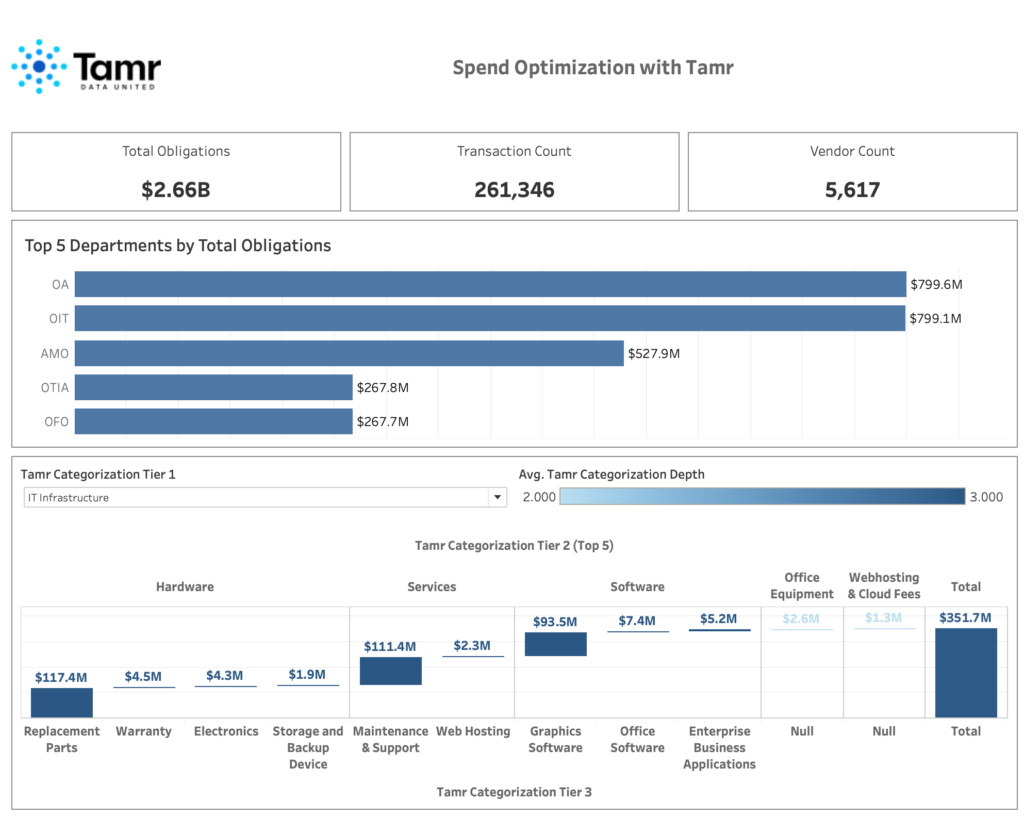How can Government agencies use spend classification and analytics to negotiate better contracts?

The United States Federal Government employs far more contractors, and administers more contracts, than any other organization in the world. To try and provide transparency for taxpayers into this activity and spending, the government maintains USASpending.gov. However, unlike the information being shared with the public, transparency between agencies across contracts and contract vehicles is almost non-existent. Why is this? And how can data mastering for spend optimization in the government fix it?
The first step is to understand where the money is spent, and then classify the spending so it can be scrutinized using analytics. In order to drive efficiencies and reduce the Federal Government debt, an improved process of budget management must be implemented, this starts with spend analytics and data visualization.
Why are contract spend metrics and performance difficult to measure?
All agencies are plagued by their inability to accurately determine spend analytic metrics versus contract performance. Three high-impact examples of this are:
- Identification of unobligated funds and current contract ‘burn rate’
- Repurposing budget dollars, ones that are ‘burning’ slowly, to more mission-critical needs
- Identifying under-performing or over-performing contracted firms

Nimbleness and flexibility are key
Consistency of services and contracts, as well as budgets across agencies, is almost non-existent. Agencies’ ability to manage, track, and provide economies of scale in buying-over-time is hampered by antiquated, disparate tracking systems—and simply the sheer volume of information. Having access to reliable spend analytics and classification is needed to ensure the government is getting the best value and performance across all contracts.
By enabling agencies and departments to quickly consolidate disparate data sources (e.g., ERP systems, legacy financial management systems, homegrown databases) in days or weeks as opposed to months or years is essential for an accurate understanding of the federal budget. Today agencies are accessing multiple systems (perhaps dozens of different systems) during the life of a contract. Unsurprisingly, these different systems track different metrics by different names and are generally not interoperable. Only through unifying and mastering their data can the government categorize materials and transform data into unified views of spend. If done correctly this allows procurement teams to more effectively negotiate with vendors, identify milestones, manage burn rate, and streamline procurement and contracting strategies.
Implementing a streamlined contract process identifies misclassified spend, purchase price variance, duplication of closely related contracts, contracts that should be renegotiated, and specific contract dependencies.
Clean data streamlines the contracting process and reduces federal spend
The key to streamlining contracting processes is to have clean classification and analytics around what has been spent. Spend analytics will reveal more insights into contract awards, suppliers, parts, and contract fulfillment thus optimizing current and future allocations. Being able to have unified views of what has been allocated will drive more efficient outcomes for existing and future contract awards. Spend classification will allow agencies to identify consistencies with prior and future purchases, invoices, and varying types of contracts such as FFPs, IDIQs, and BPAs.
Classifying and understanding spend will help to optimize the procurement strategy and identify optimal vendors and their respective adhesion to contract requirements. It will also allow the realization of cost-saving opportunities and meet mission needs faster by consolidating and categorizing spend data at an extremely granular level at an expedited pace. The time saved by the consolidation and visualization of this information can be reallocated to higher-value requirements, programs, or initiatives.
The current administrations’ initiatives to bring private-sector technology into the government to improve infrastructure will be key to address these issues. Utilizing artificial intelligence and machine learning to master spend data coupled with government expertise to train these algorithms will lead to a more streamlined contracting process and mission execution. Tamr can help consolidate contract silos, and provide visualization and insights into spend dynamics and help to eliminate the estimated 3-5% (~$30M for every $1B) of wasteful spending within contracts across the US government.



